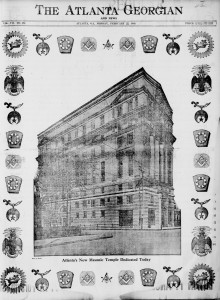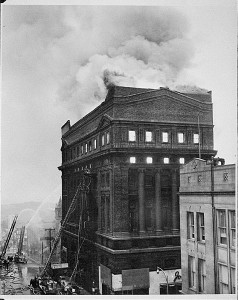
On this day in 1909, the Masonic Temple in Atlanta was opened to the public on the corner of Peachtree and Cain streets. The project took two years to complete at a cost of $250,000 and was built to serve as the headquarters for several different white Masonic groups in the Atlanta area (African American Masons met at separate locations, including the Prince Hall Masonic Lodge later in the century). The impressive structure consisted of four main stories, three mezzanine stories, and a basement. It was built with Manganese brick and featured two separate tiers of columns. The interior of the building was adorned in mahogany and contained meeting and banquet rooms to accommodate the needs of the different Masonic organizations. On February 22, the building opened to the public in a celebratory event and the Masonic Temple was featured on the front page of the Atlanta Georgian.

The Masonic Temple stood for over forty years before catching fire on September 7, 1950. The blaze began on the top floor of the structure. Authorities believed at the time that the fire originated from the torch of an elevator repairman, but the cause ultimately remained unknown. At the time of the fire, workers were also installing sprinklers to prevent such a catastrophe. The fire burned for five hours before the city’s fire department was able to extinguish the flames. All that remained of the structure the next morning was the exterior walls, which were eventually torn down. Surprisingly, not a single life was lost and only a few people suffered minor injuries, including a waitress who fainted across the street. A parking structure was eventually built in the Masonic Temple’s place and remains there today.




